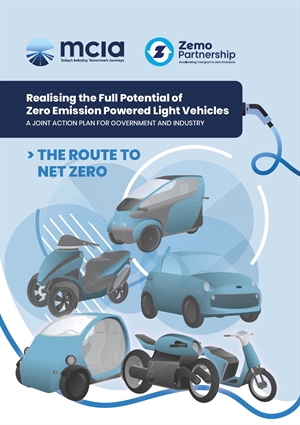Government and industry launch landmark ‘Action Plan’ for zero emission Powered Light Vehicles (PLV)
Wed 02 February 2022
View all news

(News release) The PLV (powered two, three and light four-wheeled vehicles) sector has today launched its ‘Action Plan’ for Government and industry to help realise its full potential in decarbonising the UK’s transport sector.
The Motorcycle Industry Association and transport decarbonisation specialists, Zemo Partnership, were tasked in the Government’s Transport Decarbonisation Plan[1] to identify the actions needed to create new UK business and consumer opportunities for zero emission ‘powered light vehicles’ (PLVs). This includes powered two wheelers and other ‘L-Category’ vehicles, as regulation defines them.
Today’s publication of the Action Plan shows how, working together with industry, the Government can remove barriers, which will allow zero emission PLVs to become significant modes of transport and help ensure industry and consumers are able to fully harness the opportunities they present for the environment, congestion and as affordable personal mobility solutions.
The Action Plan recommends:
- A review of existing L-Category vehicle regulation to ensure it remains fit for purpose and caters for the evolution of future zero emission PLVs, including assessing the potential for a new vehicle category.
- Developing the component and system supply chain in the UK for zero emission L3-Category powered two-wheelers (PTWs) to encourage new entrants to the market, lower manufacturing costs and maximise the potential for GHG emission savings.
- Developing the manufacturing base and supply chain in the UK for zero emission L7 cargo vehicles to increase the number and availability of models on the market, providing a greater degree of consumer and fleet choice.
- A review of the current grant and incentivisation structure in the PLV sector, including adopting learning from other vehicle categories where the roll out of zero emission tailpipe vehicles has proven successful.
- Conducting a public awareness campaign jointly led by Government and industry to promote the existence, availability, and benefits of zero emission PLVs to consumers and businesses.
- Simplifying the existing licensing regime across all L-Category segments to improve access to zero emission PLVs for a wider section of the community, increasing access, uptake and adoption.
- Increasing mobility in rural communities by providing access to affordable zero emission PLV solutions using initiatives such as Wheels to Work.
- Engaging with local authorities through the Local Authority Transport Decarbonisation Toolkit to ensure zero emission PLVs form part of an integrated transport solution for the UK.
- Creating a formal L-Category community to engage with the Government and monitor the delivery of this Action Plan.
- Engaging with industry to ensure zero emission PLVs are considered and incorporated into the development of the EV charging infrastructure.
Transport Minister Trudy Harrison MP said: "I fully welcome this Action Plan which sets out opportunities to support the resurgence of the UK's iconic motorcycle industry and put us one step closer towards making our air cleaner and lives healthier.
"As we power up the green revolution, we are determined to find the right place for zero emission PLVs within our transport network and believe they can offer an affordable, convenient and sustainable way to travel, while helping to cut congestion in our towns and cities.”
MCIA CEO, Tony Campbell, said of today’s launch: “Traditionally, powered two-wheelers and other types of PLVs have often been absent from national and local policy development due to an underappreciation or lack of awareness of their potential benefits to the environment.
“It is testament to the industry and all it has done to showcase its decarbonisation credentials that it is now regarded as a serious mode of transport for consideration alongside others, where appropriate, in the future of our transport ecosystems.
“Today’s launch of the Action Plan is a landmark day for our sector, and we look forward to continuing our work with the Government and industry to ensure the full and proper implementation of the Plan’s recommendations throughout 2022 and beyond.”
Zemo Partnership CEO, Andy Eastlake, said: “Road transport is one of the most challenging areas in terms of the achievement of net zero by 2050. Policymakers will need all the tools in the box to deliver this and ensuring every vehicle type can play its part is a critical step.
“Using the right vehicle for the right journey is a crucial element of the transition to zero emission mobility. PLVs open new opportunities to improve the efficiency with which we use road space, resources and energy, to cut greenhouse gas emissions and, potentially, also contribute to much needed improvements in urban air quality.”
The full report (‘Realising the Potential of Zero Emission Powered Light Vehicles’) is available for download here.
(For the full media release see this page.)
Related News: In December 2021, Zemo Partnership published a life-cycle analysis (LCA) to compare the greenhouse gas emissions performance of powered light vehicles (PLV), including powered two wheelers (PTW), with larger vehicles which have traditionally been used for a range of operational and leisure purposes, focusing mainly on urban areas. More information here.
Visit this page to see Zemo's latest project activity on powered light vehicles.
Footnote:
1. “We will use Zemo Partnership’s strategic partnership with the Motorcycle Industry Association (MCIA) to
stimulate and coordinate activity in this area and publish options to develop this at national and local level.”
(UK Government Transport Decarbonisation Plan, 2021, P96).
Related Links
< Back to news list